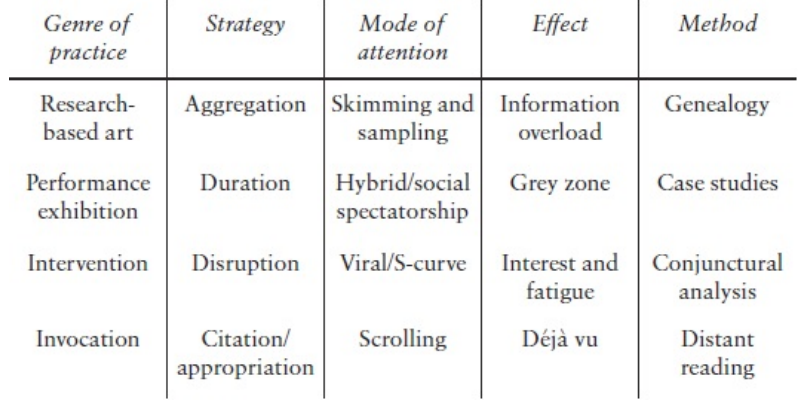created, $=dv.current().file.ctime & modified, =this.modified
tags:art
rel: Consciousness and Attention
Disordered Attention aims to move beyond the moralizing binary of attention/distraction, to dispense with attention’s economic framing, to jettison plenitudinous modern attention as an impossible ideal, and to rethink contemporary spectatorship as neither good nor bad but perpetually hybrid and collective.
Much has been written about the impact of the internet, smart-phones, and social media upon our attention spans – and most of it has been negative. But these debates do not adequately broach the new conditions of spectatorship that characterize contemporary culture. How has our attention been reorganized?
Normative Attention - an attention directed at objects (rather than other subjects), that is intellectual and cognitive (rather than sensorial and affective), that is framed in termed of ownership (“taking possession of the mind”) that and which is individual (rather than collectively or socially constituted.)
“The goal was to produce ritual immersion rather than boisterous participation in a social event.”:
In theatre, the best-known example of optical and behavioural reorganization is Richard Wagner’s design for the Festspielhaus in Bayreuth, which opened in 1876. Prior to this moment, the arrangement of seating in theatres had been a horseshoe curve in which the majority of boxes faced each other rather than the stage; Wagner changed this to an unobstructed frontal alignment in which the entire audience looks forwards.

Socialization occurred mid-performance: In the 1850s, a Parisian or London theatergoer had no compunction about talking to a neighbour in the midst of the play, if he or she had just remembered something to say. By 1870, the audience was policing itself. Talking now seemed bad taste and rude. The house lights were dimmed too, to reinforce the silence and focus attention on the stage.
Distraction
Distraction: is not the opposite of attention, then, but an accusation of misplaced attention, made in relation to an other perceived as deficient or vulnerable.
According to author, distraction is a way in which the dominant social group expressed disapproval of the subordinate group. “Your attention is in the wrong place.”
NOTE
I feel the dominant social groups in the tech space, require our distractions to maintain their positions. They profit off our distraction.
Hyperattention
Katherine Hayles - hyperattention is characterized by switching focus rapidly among different tasks, preferring multiple info streams and seeking a high level of stimulation. HA is antithetical to deep research in the humanities.
Author says HA is outdated. HA wasn’t about deep absorption in a single cultural object, but gaining a handle of adjacent discourses broadly, regardless of tech interface. It fluctuates from skimming and gists, to phases of slow thinking and writing.
tech isn’t going away; we need to engage and work through it.
As literacy has evolved in tandem with the internet and social media, the audience’s appetite for synthesizing large quantities of text has shifted – from a sense of empowered autonomy to feelings of information overload. It becomes difficult to take in everything so we triage our viewing. The mode of attention that results is skimming and sampling – reading quickly to get the gist, or sampling two or three parts of the installation rather than the whole.
Schema:

Info Overload - Research-Based Art
RBA is a genre of art characterized by a reliance on text - printed or spoken - to support an abundance of materials, distributed spatially. In place of the usual vertical arrangement on a wall (which announces itself as ‘art’), items are reoriented horizontally in a vitrine or on a table (which reads as ‘archive’).
Title
Why is art vertical and wall based, and archive horizontal?

Viewer: “Do I really need to read all of this?”
Restructuring of educational purpose):
This differs from previous models of education, in which knowledge – along with truth and reason – was one of the autonomous goals of a liberal model of education pursued for its own sake. Beginning in the 1990s, the neoliberalization of the university resignified knowledge as capital: externally funded, separated from teaching, directly linked to the functional imperatives of the economy, and evaluated using the language of finance and ‘return on investment’. Such a shift from knowledge for the public good to ‘knowledge production’ for the information economy required a fundamental rethinking of education.
Semionaut might be the best description of this tendency: drifting from signifier to signifier, the artist invents meandering trajectories between cultural signs.
Skimming and Sampling
One study reports 20% of the words of a webpage are read. (I’d expect less.) Eye-tracking studies have noticed webpages are read in an F-pattern:
A person reads the first two or three lines across the page, but as the eye travels down the screen, the scanned length gets smaller, and, by the time the bottom of the page is reached, the eye is traveling in a vertical line aligned with the left margin. (Therefore, the worst location for important information on a Web page is on the bottom right corner.)
Black Box, White Cube, Grey Zone: Performance Exhibitions and Hybrid Spectatorship
NOTE
This chapter is complicating the binaries of presence/absence and actual/virtual, arguing that smartphones introduce a new way of hybrid looking - and herald a return of a long repressed social spectatorship (mentioned above.)
Midway through the 2010s, contemporary etiquette reached a peak of anxiety over the incursion of mobile phones into theatres.
rel:Bug on Sensor
Onstage dialogue can trigger digital assistants such as Siri, leading some theaters to lock up patrons’ mobile phones until the end of the show.
Museums and galleries (often) have changed this and loosened their restrictions, now suggesting hashtags or providing QR codes. The Brooklyn Museum of Art have experiments with participatory tagging to crowd source statistics on the collection. rel: Community Manicule
Spectacle of the Museum (instagrammable): ‘perfect compatibility with the temporalized and eventized museum, in which something (anything) must happen almost all the time’. When dance is brought into the museum, he argues, ‘the visitors effectively become co-performers in… the museum as three- dimensional Facebook’
NOTE
Covered in the great Wiseman docs on the New York Public Library and the British Museum.
National Gallery (2014) & Ex Libris (2017)
Dance Theorist Andre Lepecki: The spectator versus the witness. The spectactor watches passively, instagramming cliched poses that “coldly disseminate the coordinates of presence.” The witness, by contrast, takes responsibility for the performance by transmitting it to future audiences, translating their experience into “storytelling.” Only the witness sees the whole performance and is embodied and emotionally in touch with what they are experiencing.
Two paths emerge: googling, taking photos and texting during the event, and storytelling assumed after the event. Instagram, amounts to anti-witnessing.
‘what is staged is less a historical performance than an image of that performance; the performance appears as a simulation, one designed to produce more images for circulation in the media’.
Embedded in some of these dismissive comments about performance and photography circulation is latent snobbery - one that objects to people taking their own pictures and interpreting them by adding their own captions.
Thought
“coldly disseminate the coordinates of presence”
snobbery, you don’t say?
Low and high culture experience: An outmoded distinction between high and low culture persists: slow absorptive looking is held up as the high cultural ideal, while live forms of mass entertainment (music concerts, sports events) can be consumed with a camera phone in hand.
The grey zone, black cube and white cube
The grey zone results from the convergence of experimental theatre’s ‘black box’ and the art gallery’s ‘white cube’ and gives rise to a new set of spectatorial protocols, at the centre of which is networked technology. While Sehgal can be said to have devised the protocols for sustaining performance continually in an exhibition space in 2000, it is telling that he prohibited photography of his work. Sehgal thought that mystique and rumour were key to the value of his ephemeral situations, and for a while that was true. By the time of his high-profile solo exhibition at the Guggenheim Museum, New York in 2010, however, it was no longer possible to control the photographic circulation of his works. The iPhone enabled a more discreet, rapid, and silent type of digital photography that was nearly impossible to monitor.
Text discusses Andy Warhol’s Sleep, a six hour film of his lover sleeping.
rel: Tired film
The term black box designates the spatial equivalent of a temporal convention and its mode of attention.
Exhibition time is different, linked to museum opening hours. It is governed by self direction, desynchronized timing and has a mode of attention housed in the white cube which aspires to be a blend of objectivity, timelessness and sanctity.
Plastic
Liminal, slow dance: rel:Contradance and Slow dance
Choreographer Maria Hassabi has long specialized in extremely slow
dances presented as hour-long theatrical performances. PLASTIC (2015) marks her most ambitious realization of this genre to date, as it occupied several spaces at each of the three museums where it was performed, turning dance into an exhibition, albeit one that appeared in transitional areas like lobbies and staircases.
Their decelerated movements formed a counterpoint composition to the crowds of museum visitors. At moments – as the dancers crawled across the floor, arched over a couch, or inched down the stairs – they even resembled lifeless corpses, as if recently shot or felled by hazardous gas, an impression that was particularly striking when viewed from a balcony above. This abject horizontality contrasted with the vertical visitors, who either stepped over the dancers as if nothing were happening, or stared at them, moved closer, and reached automatically for their camera phones. The dancers’ proximity to objecthood, due largely to their extremely slow movements, seemed to encourage audiences to photograph them, even to the point of being intrusive.
Faust
Visitors entered the pavilion on a highly reflective glass surface, raised about four feet above the existing floor, beneath which one could see a cast of ten dancers engaged in a range of affectless poses and desultory activities, which included checking their phones. Occasionally the performers emerged from under the glass floor to share the viewer’s space, or to perch on protruding shelves, or stand behind glass partitions. Although the performers were all trained dancers, held poses were more important than movement; this rendered the work self-consciously photogenic, exuding an attitude and sensibility familiar from fashion magazines and advertising.
Today, the technological prosthesis has simply changed – we no longer wield opera glasses but tablets and smartphones.
Seizing the Moment: Interventions
Definition: interventions as self-initiated actions that address the polis through the use of public space, employing an everyday visual language, and harnessing the media to force an issue into public consciousness and spark debate.
Interventions are predicated on the peak-and-decay model of viral attention, characteristic of epidemics, it follows a sigmoid curve, a slow start followed by huge acceleration, to a tipping point and precipitous drop.
Intervention use public space, and are unauthorized and lack official permission. This is because they respond to an urgency, seek to focus attention quickly, and cannot wait for an invitation in order to trigger a debate.

Déjà Vu: Invoking Modernist Architecture and Design
Unlike pagination, scrolling produces an amorphous relationship to time and space. When scrolling through a webpage, it’s often hard to locate how far we are through the material and we have no idea how much more there is to come.
Most of the works I have only seen as images online.
Often we look at JPEGs to decide whether we should go and stand in a gallery.
